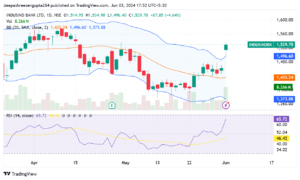IndusInd Bank, incorporated in April 1994, is named after the Indus Valley Civilization. The bank was envisioned by Srichand P Hinduja, a Non-Resident Indian businessman and head of the Hinduja Group. Over the years, IndusInd Bank has grown into a prominent private sector bank in India, offering a wide range of products and services to its customers.

Positional Trade in IndusInd Bank
Trade Setup
– Stock: IndusInd Bank
– Entry Point: Looks good above ₹1528
– Stop Loss (SL): ₹1510
– Targets: 5-7-9-10-12-15-20-25-30 points from entry
– Holding Period: A few days
Advisory Note
Please consult your financial advisor before investing. This research is for educational purposes only.
Technical Analysis
Recent Performance
IndusInd Bank recently closed at ₹1461.85, crossing its previous week’s high of ₹1451.00 by 0.75%. This movement indicates a positive momentum and a potential breakout from previous resistance levels.
Insider Deals
There have been several insider deals recently:
– Rohan Jathanna sold 1000 shares.
– Sriram A G sold 1385 shares.
– Anil Marco Rao sold 1000 shares.
While insider selling can sometimes be a concern, it’s important to consider the overall market sentiment and the reasons behind these sales. They may not necessarily indicate negative prospects for the stock.
Volume Analysis
The stock appears ready to cross past barriers with good volumes, suggesting strong buying interest and potential for further upward movement.
Fundamental Analysis
Sector and Industry
– Sector: Banking
– Industry: Bank – Private
Financial Metrics
– Market Capitalization: ₹1,13,641.41 Cr.
– Category: Large Cap
– Enterprise Value (EV): Not specified
– Book Value / Share: ₹808.12
– Price-Earning Ratio (PE): 12.66
– PEG Ratio: 0.81
– Dividend Yield: 1.13%
These metrics indicate that IndusInd Bank is a significant player in the private banking sector with a reasonable valuation and a decent dividend yield.
Strategic Positioning
IndusInd Bank has a robust market presence and a diversified portfolio of banking products and services. Its strategic initiatives and technological advancements have positioned it well for future growth.
Investment Rationale
Technical Breakout
The stock is on the verge of a breakout, as indicated by its recent performance and volume surge. This breakout can lead to substantial gains for positional traders who enter at the right time.
Strong Fundamentals
IndusInd Bank’s solid financial metrics and strategic positioning make it a viable candidate for investment. Its PE ratio of 12.66 and PEG ratio of 0.81 suggest that the stock is reasonably priced relative to its growth prospects.
Market Sentiment
The recent insider selling might raise some eyebrows, but the overall market sentiment towards IndusInd Bank remains positive. The stock’s ability to cross past resistance levels with good volumes indicates strong buying interest.
Detailed Technical Analysis
Moving Averages
– Simple Moving Average (SMA): Monitor the 50-day and 200-day SMAs to understand long-term trends. If the 50-day SMA crosses above the 200-day SMA, it signals a bullish trend, known as a “Golden Cross.”
– Exponential Moving Average (EMA): Compare the 20-day EMA with the 50-day EMA to get insights into short-term trends.
Relative Strength Index (RSI)
– RSI Calculation: The RSI measures the magnitude of recent price changes to evaluate overbought or oversold conditions. An RSI above 70 typically indicates that the stock is overbought, while an RSI below 30 suggests it is oversold.
– RSI Divergence: Look for divergences where the price is moving in the opposite direction of the RSI, indicating a potential reversal.
Bollinger Bands
– Band Width: Bollinger Bands consist of a middle band (SMA) and an upper and lower band. The distance between the bands (bandwidth) indicates volatility.
– Price Action: Observe if the stock price is touching the upper or lower bands. A move towards the upper band indicates buying pressure, while a move towards the lower band indicates selling pressure.
MACD (Moving Average Convergence Divergence)
– MACD Line and Signal Line: The MACD line is the difference between the 26-day and 12-day EMAs. The signal line is the 9-day EMA of the MACD line. A bullish signal occurs when the MACD line crosses above the signal line.
– Histogram: The histogram shows the difference between the MACD line and the signal line. Positive values indicate bullish momentum, while negative values indicate bearish momentum.
Fibonacci Retracement
– Key Levels: Fibonacci retracement levels (23.6%, 38.2%, 50%, 61.8%, and 78.6%) are used to identify potential support and resistance levels.
– Application: Apply Fibonacci retracement to recent significant price movements to predict potential pullback levels.
Positional Trading Strategy
Entry Strategy
– Initial Entry Point: Buy IndusInd Bank at ₹1528.
– Accumulation Strategy: If the stock price drops to ₹1510, accumulate more shares to reduce the average purchase price and enhance potential returns.
Exit Strategy
– Target Prices: Set incremental target prices at 5, 7, 9, 10, 12, 15, 20, 25, and 30 points from the entry price. This allows for partial profit-taking at each level, locking in gains while still participating in potential further upside.
– Trailing Stop Loss: Use a trailing stop loss to protect profits. Adjust the stop loss level as the stock price moves up, maintaining a certain percentage below the current market price.
Risk Management
– Stop Loss: Set an initial stop loss slightly below the entry price, at ₹1510, to limit potential losses if the trade goes against expectations.
– Position Sizing: Determine the size of the position based on your risk tolerance and overall portfolio size. Avoid over-allocating to a single stock to maintain diversification.
Monitoring and Adjusting the Trade
Regular Updates
– Technical Indicators: Continuously monitor key technical indicators such as RSI, MACD, and Bollinger Bands to assess the stock’s performance.
– News and Events: Stay updated with news and events related to IndusInd Bank and the banking sector. Significant news can impact stock prices and may require adjustments to your trading strategy.
Adjusting Targets and Stop Losses
– Revising Targets: If the stock shows strong upward momentum, consider revising your target prices upwards to capture additional gains.
– Adjusting Stop Losses: As the stock price moves up, adjust your trailing stop loss to lock in profits and protect against sudden reversals.
Fundamental Analysis: In-Depth Look
Financial Performance
– Revenue Analysis: Examine the company’s revenue growth over the past five years. Consistent growth indicates a strong market presence and effective business strategy.
– Net Profit Margin: Assess the net profit margin to understand how much of the revenue is converted into profit. A higher margin indicates efficient cost management.
Balance Sheet Strength
– Total Assets and Liabilities: Review the total assets and liabilities to gauge the company’s financial health. A strong balance sheet with manageable debt levels is crucial for long-term sustainability.
– Debt-to-Equity Ratio: Calculate the debt-to-equity ratio to assess the company’s leverage. A lower ratio indicates lower financial risk.
Cash Flow Analysis
– Operating Cash Flow: Positive operating cash flow indicates that the company generates sufficient cash from its core operations to fund its activities.
– Investing Cash Flow: Review the capital expenditures and investments in new projects to understand the company’s growth initiatives.
– Financing Cash Flow: Analyze the cash flow from financing activities, including debt issuance and repayment, dividend payments, and share buybacks.
Dividend Policy
– Dividend Payout Ratio: The dividend payout ratio indicates the percentage of earnings paid out as dividends. A sustainable payout ratio ensures that the company can maintain dividend payments while investing in growth.
– Dividend Yield: A dividend yield of 1.13% provides a modest income stream. Compare this with industry peers to evaluate the attractiveness of the yield.
Strategic Insights: Future Prospects
Expansion and Growth Plans
– Branch Expansion: IndusInd Bank’s plans to expand its branch network and digital presence will drive future growth.
– Technological Advancements: Investments in digital banking and fintech solutions position the bank as a leader in providing innovative banking services.
Customer Base
– Retail and Corporate Banking: IndusInd Bank’s diverse customer base, spanning retail and corporate banking, provides a stable revenue stream and reduces dependency on any single segment.
– Customer Service Excellence: The bank’s focus on customer service excellence and personalized banking solutions enhances customer loyalty and retention.
Regulatory Environment
– Government Policies: Favorable government policies promoting financial inclusion and digital banking support the bank’s growth prospects.
– Regulatory Compliance: Adhering to regulatory standards and guidelines ensures smooth operations and minimizes legal risks.
IndusInd Bank presents a compelling opportunity for positional traders due to its strong technical and fundamental indicators.
With a recent breakout above ₹1528 and robust financial health, the stock is poised for significant upward movement. Here is a comprehensive guide on why and how to trade IndusInd Bank as a positional trade:
Detailed Positional Trade Strategy
Technical Indicators
Moving Averages
– 50-day SMA: The stock trading above its 50-day SMA indicates a bullish trend.
– 200-day SMA: Similarly, trading above the 200-day SMA confirms a long-term upward trend.
Relative Strength Index (RSI)
– RSI Level: Currently, the RSI is shifting towards the upper direction, suggesting increasing buying momentum. An RSI between 50 and 70 typically indicates a bullish trend without being overbought.
Bollinger Bands
– Band Analysis: The stock price moving towards the upper Bollinger Band indicates that it is experiencing upward price momentum. This suggests a possible continuation of the bullish trend.
MACD (Moving Average Convergence Divergence)
– MACD Line and Signal Line: The MACD line crossing above the signal line is a bullish indicator, suggesting potential for further price increases.
Fibonacci Retracement
– Key Levels: Applying Fibonacci retracement to recent price movements helps identify support and resistance levels, providing potential entry and exit points. Key levels to watch are the 38.2%, 50%, and 61.8% retracements.
Entry and Exit Strategy
Entry Strategy
– Initial Entry: Enter the trade at ₹1528.
– Accumulation: If the stock price pulls back to ₹1510, accumulate more shares to lower the average cost.
Exit Strategy
– Target Prices: Set staggered target prices at intervals of 5, 7, 9, 10, 12, 15, 20, 25, and 30 points from the entry price. This allows for incremental profit-taking while keeping some position open for potential higher gains.
Stop Loss
– Initial Stop Loss: Set at ₹1510 to limit downside risk.
– Trailing Stop Loss: Adjust the stop loss upward as the stock price increases to lock in profits while allowing for further gains.
Monitoring the Trade
Regular Updates
– Technical Analysis: Continuously monitor technical indicators to assess the ongoing trend and momentum.
– Market News: Stay updated with news related to IndusInd Bank and the broader banking sector to anticipate any impact on the stock price.
Adjusting Targets and Stop Losses
– Revising Targets: If the stock shows strong upward momentum, consider revising the target prices upward.
– Adjusting Stop Losses: Move the trailing stop loss upward to protect gains as the stock price rises.
Fundamental Analysis
Financial Performance
Revenue and Profit Growth
– Revenue Trends: Examine the bank’s revenue growth over the past few years. Consistent revenue growth indicates a strong business model and market position.
– Profit Margins: Evaluate net profit margins to understand how effectively the bank converts revenue into profit. Higher margins are a positive indicator of financial health.
Balance Sheet Strength
– Assets and Liabilities: Review the total assets and liabilities to gauge the bank’s financial stability. A healthy balance sheet with a low debt-to-equity ratio indicates strong financial health.
– Capital Adequacy Ratio (CAR): A high CAR ensures that the bank has sufficient capital to absorb potential losses, enhancing its financial stability.
Cash Flow Analysis
Operating Cash Flow
– Positive Cash Flow: Consistent positive operating cash flow indicates that the bank generates enough cash from its core operations to fund its activities.
Investing and Financing Cash Flow
– Capital Expenditures: Assess investments in new branches, technology, and other growth initiatives.
– Dividend Payments and Debt Management: Analyze the cash flow from financing activities to understand how the bank manages its capital structure.
Dividend Policy
– Dividend Payout Ratio: A sustainable payout ratio indicates that the bank can continue to pay dividends without compromising its growth potential.
– Dividend Yield: A yield of 1.13% provides a steady income stream for investors, enhancing the stock’s attractiveness.
Strategic Insights
Expansion and Growth
Branch Network Expansion
– New Branches: IndusInd Bank’s plans to expand its branch network will drive future growth by increasing its market reach.
Digital Banking
– Technological Advancements: Investments in digital banking and fintech solutions position the bank as a leader in providing innovative banking services.
Customer Base
Retail and Corporate Banking
– Diverse Customer Base: IndusInd Bank’s diverse customer base, including retail and corporate clients, provides a stable revenue stream and reduces dependency on any single segment.
– Customer Service Excellence: The bank’s focus on customer service excellence and personalized banking solutions enhances customer loyalty.
Regulatory Environment
Government Policies
– Financial Inclusion Initiatives: Favorable government policies promoting financial inclusion and digital banking support the bank’s growth prospects.
Regulatory Compliance
– Adherence to Standards: Ensuring compliance with regulatory standards minimizes legal risks and ensures smooth operations.
Market Sentiment
Insider Deals
Recent insider deals, where several executives sold shares, might raise concerns. However, insider selling does not necessarily indicate negative prospects. It’s essential to consider the overall market sentiment and the stock’s performance.
Industry Position
IndusInd Bank is well-positioned in the private banking sector, with strong financial metrics and a strategic focus on growth and innovation. Its PE ratio of 12.66 and PEG ratio of 0.81 suggest that the stock is reasonably priced relative to its growth prospects.
IndusInd Bank presents a compelling opportunity for positional traders due to its strong technical and fundamental indicators.
The stock’s recent breakout above ₹1528, combined with solid financial health and strategic initiatives, makes it a viable candidate for investment.
– Technical Breakout: The stock is on the verge of a breakout, indicating potential for significant gains.
– Strong Fundamentals: IndusInd Bank’s financial metrics and strategic positioning make it a sound investment.
– Market Sentiment: Despite recent insider selling, the overall market sentiment remains positive.
Investors should consult their financial advisor before making investment decisions. This research is for educational purposes only.
Final Note
IndusInd Bank’s potential for upward movement, coupled with its strong financial health and strategic initiatives, presents an excellent opportunity for positional trading.
Monitoring key technical indicators, staying updated with market news, and adjusting the trading strategy as needed will help maximize returns and manage risks effectively.
ALSO READ: Positional Trading with JSW Energy: An In-Depth Guide




